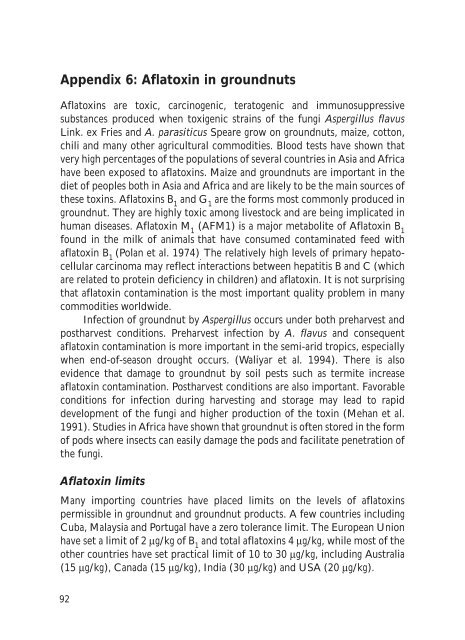Market Prospects for Groundnut in West Africa COMMON FUND ...
Market Prospects for Groundnut in West Africa COMMON FUND ...
Market Prospects for Groundnut in West Africa COMMON FUND ...
Create successful ePaper yourself
Turn your PDF publications into a flip-book with our unique Google optimized e-Paper software.
Appendix 6: Aflatox<strong>in</strong> <strong>in</strong> groundnuts<br />
Aflatox<strong>in</strong>s are toxic, carc<strong>in</strong>ogenic, teratogenic and immunosuppressive<br />
substances produced when toxigenic stra<strong>in</strong>s of the fungi Aspergillus flavus<br />
L<strong>in</strong>k. ex Fries and A. parasiticus Speare grow on groundnuts, maize, cotton,<br />
chili and many other agricultural commodities. Blood tests have shown that<br />
very high percentages of the populations of several countries <strong>in</strong> Asia and <strong>Africa</strong><br />
have been exposed to aflatox<strong>in</strong>s. Maize and groundnuts are important <strong>in</strong> the<br />
diet of peoples both <strong>in</strong> Asia and <strong>Africa</strong> and are likely to be the ma<strong>in</strong> sources of<br />
these tox<strong>in</strong>s. Aflatox<strong>in</strong>s B 1 and G 1 are the <strong>for</strong>ms most commonly produced <strong>in</strong><br />
groundnut. They are highly toxic among livestock and are be<strong>in</strong>g implicated <strong>in</strong><br />
human diseases. Aflatox<strong>in</strong> M 1 (AFM1) is a major metabolite of Aflatox<strong>in</strong> B 1<br />
found <strong>in</strong> the milk of animals that have consumed contam<strong>in</strong>ated feed with<br />
aflatox<strong>in</strong> B 1 (Polan et al. 1974) . The relatively high levels of primary hepatocellular<br />
carc<strong>in</strong>oma may reflect <strong>in</strong>teractions between hepatitis B and C (which<br />
are related to prote<strong>in</strong> deficiency <strong>in</strong> children) and aflatox<strong>in</strong>. It is not surpris<strong>in</strong>g<br />
that aflatox<strong>in</strong> contam<strong>in</strong>ation is the most important quality problem <strong>in</strong> many<br />
commodities worldwide.<br />
Infection of groundnut by Aspergillus occurs under both preharvest and<br />
postharvest conditions. Preharvest <strong>in</strong>fection by A. flavus and consequent<br />
aflatox<strong>in</strong> contam<strong>in</strong>ation is more important <strong>in</strong> the semi-arid tropics, especially<br />
when end-of-season drought occurs. (Waliyar et al. 1994). There is also<br />
evidence that damage to groundnut by soil pests such as termite <strong>in</strong>crease<br />
aflatox<strong>in</strong> contam<strong>in</strong>ation. Postharvest conditions are also important. Favorable<br />
conditions <strong>for</strong> <strong>in</strong>fection dur<strong>in</strong>g harvest<strong>in</strong>g and storage may lead to rapid<br />
development of the fungi and higher production of the tox<strong>in</strong> (Mehan et al.<br />
1991). Studies <strong>in</strong> <strong>Africa</strong> have shown that groundnut is often stored <strong>in</strong> the <strong>for</strong>m<br />
of pods where <strong>in</strong>sects can easily damage the pods and facilitate penetration of<br />
the fungi.<br />
Aflatox<strong>in</strong> limits<br />
Many import<strong>in</strong>g countries have placed limits on the levels of aflatox<strong>in</strong>s<br />
permissible <strong>in</strong> groundnut and groundnut products. A few countries <strong>in</strong>clud<strong>in</strong>g<br />
Cuba, Malaysia and Portugal have a zero tolerance limit. The European Union<br />
have set a limit of 2 μg/kg of B 1 and total aflatox<strong>in</strong>s 4 μg/kg, while most of the<br />
other countries have set practical limit of 10 to 30 μg/kg, <strong>in</strong>clud<strong>in</strong>g Australia<br />
(15 μg/kg), Canada (15 μg/kg), India (30 μg/kg) and USA (20 μg/kg).<br />
92

















